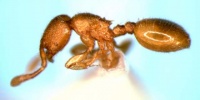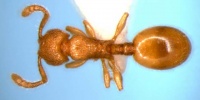Myrmecina flava
| Myrmecina flava | |
|---|---|

| |
| Scientific classification | |
| Kingdom: | Animalia |
| Phylum: | Arthropoda |
| Class: | Insecta |
| Order: | Hymenoptera |
| Family: | Formicidae |
| Subfamily: | Myrmicinae |
| Tribe: | Crematogastrini |
| Genus: | Myrmecina |
| Species: | M. flava |
| Binomial name | |
| Myrmecina flava Terayama, 1985 | |
| Common Name | |
|---|---|
| Kiiro-kadofushi-ari | |
| Language: | Japanese |
This species nests in soil. The type-locality is Kawasaki City, Kanagawa Prefecture, Japan, and it is rarely encountered (Japanese Ant Image Database).
Identification
This species is easily distinguished by its yellow body color, and the unique structure of its antennal bases (Japanese Ant Image Database).
Distribution
Latitudinal Distribution Pattern
Latitudinal Range: 36.78111111° to 33.8446°.
| North Temperate |
North Subtropical |
Tropical | South Subtropical |
South Temperate |
- Source: AntMaps
Distribution based on Regional Taxon Lists
Palaearctic Region: Democratic Peoples Republic of Korea, Japan (type locality), Republic of Korea.
Distribution based on AntMaps
Distribution based on AntWeb specimens
Check data from AntWeb
Countries Occupied
| Number of countries occupied by this species based on AntWiki Regional Taxon Lists. In general, fewer countries occupied indicates a narrower range, while more countries indicates a more widespread species. |

|
Estimated Abundance
| Relative abundance based on number of AntMaps records per species (this species within the purple bar). Fewer records (to the left) indicates a less abundant/encountered species while more records (to the right) indicates more abundant/encountered species. |

|
Biology
Castes

| |
| . | |
Nomenclature
The following information is derived from Barry Bolton's Online Catalogue of the Ants of the World.
- flava. Myrmecina flava Terayama, 1985a: 35, figs. 1-5 (w.q.) JAPAN. See also: Lyu & Cho, 2003a: 189.
Description
References
- Aswaj, P., Anoop, K., Priyadarsanan, D.R. 2021. Description of two new species of ants of the genus Myrmecina Curtis, 1829 (Hymenoptera: Formicidae: Myrmicinae) from the Eastern Himalayas. Zootaxa 4990, 160–171 (doi:10.11646/zootaxa.4990.1.10).
- Hisasue, Y. 2018. Ant fauna of Matsuyama Castle. ARI 39: 18-36.
- Hisasue, Y. 2020. A checklist of the ants of Mt. Hiko-san (Kyushu, Japan). Korasana 93: 31-38.
- Lin, C.-C., Wu, W.-J. 1998. The ant tribe Myrmecinini (Hymenoptera: Formicidae) of Taiwan. Chinese Journal of Entomology 18: 83-100.
- Lyu, D.-P.; Cho, S. 2003a. Review of genus Myrmecina (Hymenoptera: Formicidae: Myrmicinae) of Korea. Insecta Koreana 20: 187-193.
- Masuko, K. 1995 ("1994"). Specialized predation on oribatid mites by two species of the ant genus Myrmecina (Hymenoptera: Formicidae). Psyche (Cambridge) 101:159-173. [1995-11-20]
- Terayama, M. 1985d. Two new species of the ant genus Myrmecina (Insecta; Hymenoptera; Formicidae) from Japan and Taiwan. Edaphologia 32: 35-40 (page 35, worker, queen described figs. 1-5)
References based on Global Ant Biodiversity Informatics
- Guénard B., and R. R. Dunn. 2012. A checklist of the ants of China. Zootaxa 3558: 1-77.
- Hosoichi S., W. Tasen, S. H. Park. A. Le Ngoc, Y. Kuboki, and K. Ogata. 2015. Annual fire resilience of ground-dwelling ant communities in Hiraodai Karst Plateau grassland in Japan. Entomological Science 18: 254–261.
- Hosoichi S. 2014. Additional records of Messor aciculatus F. Smith and Myrmecina flava Terayama from Nokonoshima Island. Pulex 93: 646-647.
- Kawahara Y., S. Hosoyamada, and S. Yamane. 1999. Ant fauna of the Terayama Station for Education and Research on Nature, Kagoshima University. Bulletin of the Faculty of Education, Kagoshima University. Natural Science 50: 147-156.
- Lyu D.-P.; Cho S. 2003. Review of genus Myrmecina (Hymenoptera: Formicidae: Myrmicinae) of Korea. Insecta Koreana 20: 187-193.
- Masuko, K. 2010. Nest density and distribution of subterranean ants in an evergreen broadleaf forest in Japan with special reference to Amblyopone silvestrii. Entomological Science 13:193
- Miyama Y., and F. Ito. 2000. A supplementary note on ant fauna in Kagawa Prefecture (2). Ari 24: 12.
- Radchenko, A. 2005. Monographic revision of the ants (Hymenoptera: Formicidae) of North Korea. Annales Zoologici (Warsaw) 55: 127-221.
- Radchenko, A. 2005. Monographic revision of the ants (Hymenoptera, Formicidae) of North Korea. Annales Zoologici 55(2): 127-221.
- Terayama M. 1985. Two new species of the ant genus Myrmecina (Insecta; Hymenoptera; Formicidae) from Japan and Taiwan. Edaphologia 32: 35-40.
- Terayama M. 1992. Structure of ant communities in East Asia. A. Regional differences and species richness. Bulletin of the Bio-geographical Society of Japan 47: 1-31.
- Terayama M., K. Ogata, and B.M. Choi. 1994. Distribution records of ants in 47 prefectures of Japan. Ari (report of the Myrmecologists Society of Japan) 18: 5-17.
- Yamane S., Y. Harada, and K. Eguchi. 2013. Classification and ecology of ants. Natural history of ants in Southern Kyushu. 200 pages

